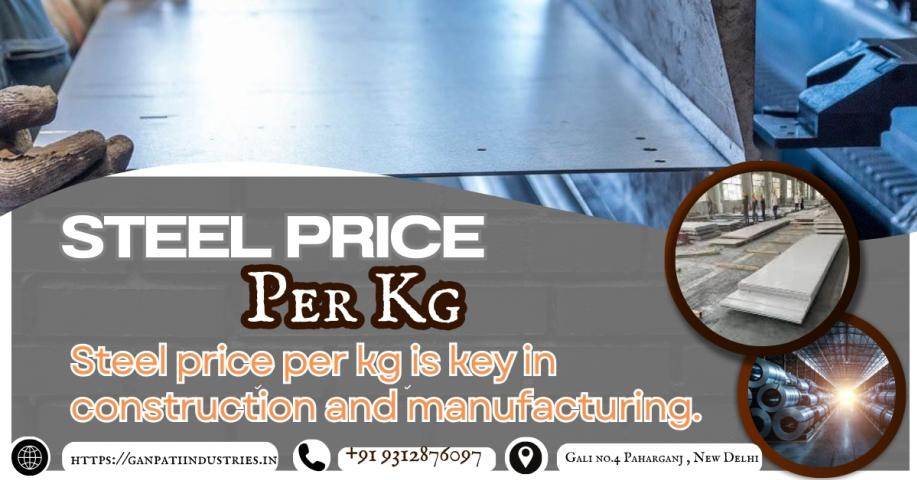Steel is one of the most crucial materials in modern industry, playing a vital role in construction, automotive manufacturing, infrastructure, and numerous other sectors. The price of steel per kilogram is a crucial indicator of economic health and industrial activity. This article delves into the factors influencing steel prices, recent trends, and the implications for various industries and consumers.
Factors Influencing Steel Prices
Raw Material Costs:
Iron Ore: Iron ore is the primary raw material for steel production. Iron ore prices can fluctuate due to changes in demand, supply chain disruptions, and geopolitical factors. For instance, primary iron ore producers like Australia and Brazil significantly impact global steel prices.
Coking Coal: Coking coal is another essential input in steel manufacturing. Price variations in coking coal, often due to mining issues or transportation challenges, directly affect steel prices.
Production Costs:
Energy Costs: Steel production is energy-intensive, requiring substantial electricity and fuel. Variations in energy prices, influenced by oil and gas prices or renewable energy policies, can change steel prices.
Labor Costs: Labor costs in steel-producing regions also impact overall production costs. Higher wages or labor strikes can lead to increased steel prices.
Market Demand:
Construction and Infrastructure Projects: Large-scale infrastructure projects and construction booms can increase steel demand, leading to higher prices. Conversely, economic slowdowns or reduced construction activities can depress steel prices.
Automotive and Manufacturing Industries: The demand from the automotive and manufacturing sectors is another critical factor. Technological advancements or shifts toward alternative materials can influence steel demand.
Global Trade Policies:
Tariffs and Quotas: Government-imposed tariffs and quotas on steel imports and exports can significantly impact prices. For example, the US imposed tariffs on steel imports in 2018, which affected global steel prices and trade dynamics.
Trade Agreements: Bilateral or multilateral agreements between countries can ease or restrict steel trade, influencing prices.
Economic Conditions:
Global Economic Health: The overall global economic condition affects steel prices. Economic growth leads to higher demand and prices, while recessions can lead to lower demand.
Currency Exchange Rates: Exchange rate fluctuations between steel-exporting and importing countries can affect prices. A stronger local currency can make exports more expensive and imports cheaper, impacting domestic steel prices.
Recent Trends in Steel Prices
Over the past few years, steel prices have shown considerable volatility due to various global events:
COVID-19 Pandemic:
The pandemic led to significant disruptions in the supply chain, affecting production and transportation. As economies started recovering, the steel demand surged, leading to price hikes.
Supply Chain Disruptions:
Issues like the Suez Canal blockage and port congestions have contributed to supply chain challenges, affecting steel availability and prices.
Environmental Regulations:
Stricter environmental regulations in major steel-producing countries like China have reduced production capacities, influencing global steel prices.
Implications of Steel Price Fluctuations
Construction Industry:
Fluctuations in steel prices directly impact the cost of construction projects. Higher steel prices can lead to increased project costs and delays, affecting public and private sector projects.
Automotive Industry:
Steel is a crucial material in automotive manufacturing. Price increases can lead to higher production costs, potentially raising the prices of vehicles and affecting consumer demand.
Manufacturing Sector:
Various manufacturing sectors rely on steel for production. Fluctuating steel prices can lead to changes in production costs, influencing product pricing and profitability.
Consumer Goods:
The cost of consumer goods that use steel, such as appliances and electronics, can be affected by changes in steel prices, impacting affordability for consumers.
Investment and Trade:
Steel price trends influence investment decisions in related industries and stock markets. Additionally, trade balances between steel-exporting and importing countries can be affected by price fluctuations.
Strategies to Mitigate Price Volatility
Diversified Sourcing:
Companies can mitigate price volatility by diversifying their sources of raw materials and suppliers, reducing dependency on a single source.
Long-Term Contracts:
Engaging in long-term contracts with fixed prices can help companies stabilize costs and manage budget expectations.
Technological Innovations:
Investing in technological innovations to improve production efficiency and reduce costs can offset the impact of rising raw material prices.
Alternative Materials:
Exploring alternative materials that can replace steel in specific applications can minimize dependency on steel and mitigate the effects of price fluctuations.
Conclusion
Various factors, including raw material costs, production expenses, market demand, global trade policies, and economic conditions, influence steel prices per kilogram. Understanding these factors is crucial for industries and consumers to navigate the implications of steel price volatility. By adopting strategic measures, businesses can mitigate the impact of fluctuating steel prices and maintain stability in their operations.



